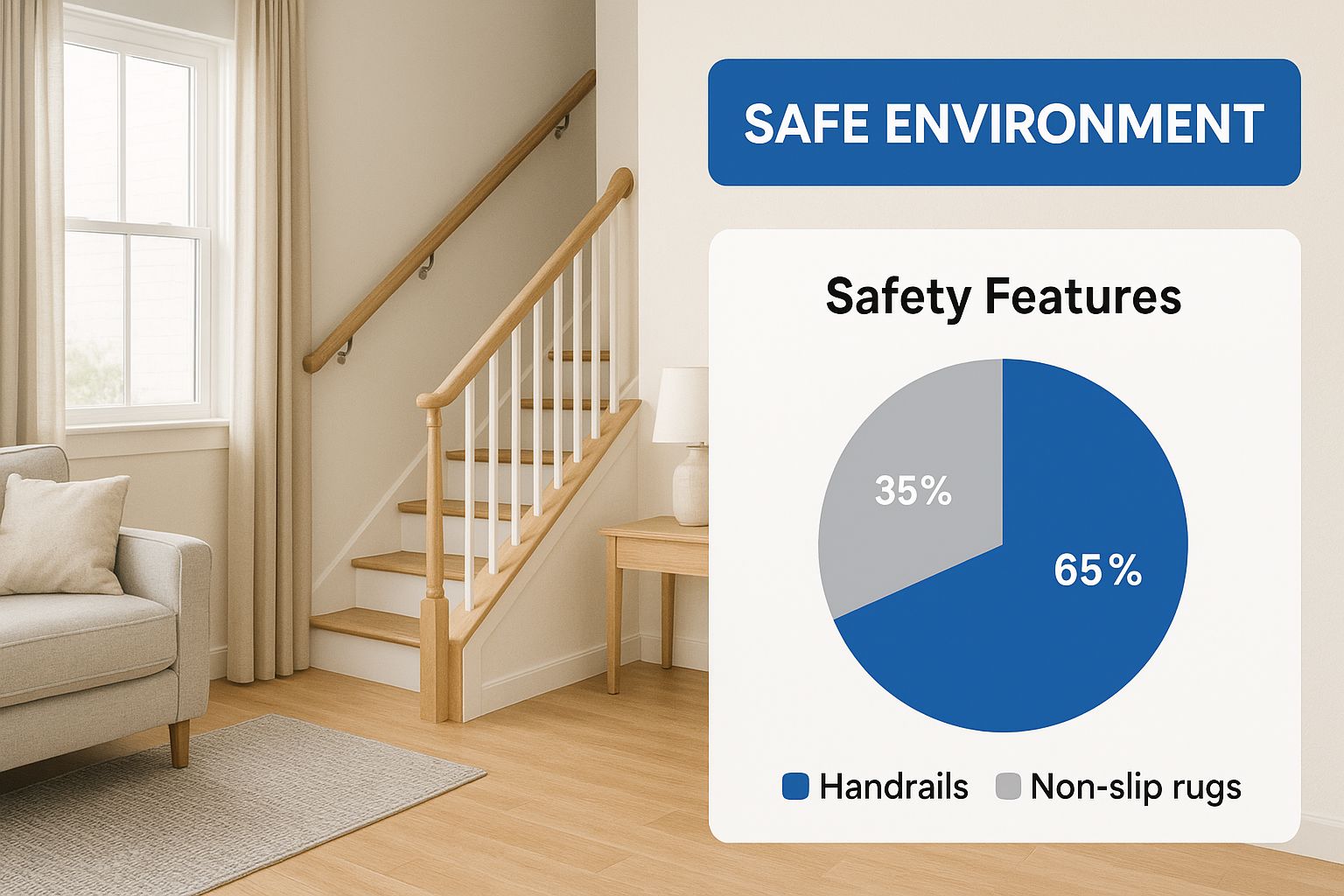The Essence of Home Care: Why It's Transforming Senior Living
The senior care landscape is evolving. There's a noticeable shift away from institutionalized care and towards personalized support at home. Home care isn't just about basic assistance anymore; it's a holistic approach prioritizing independence, dignity, and overall well-being. This change reflects a growing desire among seniors to age in place, surrounded by the comfort of familiar belongings and cherished memories.
Understanding the Growing Need for Home Care
The demand for home care is on the rise, driven by changing demographics and an aging population. By 2030, projections indicate that one in five Americans will be 65 or older. This significant increase highlights the growing need for adaptable and individualized care options. Further emphasizing this point, the home care market, valued at approximately $250 billion in 2023, is expected to reach $383 billion by 2028. This growth reflects the significant and increasing demand for home-based caregiving. This surge is primarily attributed to demographic changes, with the 65+ population projected to potentially reach 95 million by 2060. For a deeper dive into these statistics, check out this resource: The Growing Demand For Home Care
Medical vs. Non-Medical Home Care: Defining the Difference
Home care encompasses a broad spectrum of services designed to meet individual requirements. A key distinction lies between medical and non-medical home care. Medical home care involves skilled nursing, medication management, wound care, and other medical procedures administered by licensed professionals. This type of care addresses complex health needs, often following a hospital stay or rehabilitation period.
Non-medical home care, on the other hand, focuses on assistance with Activities of Daily Living (ADLs). These include tasks such as bathing, dressing, meal preparation, and transportation. Provided by trained caregivers, these services empower seniors to maintain their independence and enhance their overall quality of life. This distinction offers families diverse choices based on their loved one's unique care needs.
Why Families Choose Home Care: Beyond the Basics
The advantages of home care extend beyond mere practical support. It enables seniors to stay in familiar environments, which can significantly improve emotional well-being and reduce stress. This is especially vital for individuals experiencing cognitive decline, as a consistent and recognizable setting can help minimize confusion and anxiety.
Home care also strengthens family bonds. By reducing the burden of daily caregiving tasks, family members have more opportunities for meaningful interactions and quality time with their loved ones. Additionally, home care offers personalized attention and companionship, addressing the social and emotional needs of seniors. This individualized support leads to an enhanced quality of life and a stronger sense of independence for those receiving care.
The Profound Benefits of Aging Where You Belong
There's something inherently comforting about remaining in familiar surroundings, a place filled with cherished memories and personal significance. This is especially true for seniors, for whom home represents much more than just a building. It's a sanctuary, a testament to a lifetime of experiences. This section explores the significant advantages – psychological, physical, social, and financial – of receiving home care.
Psychological Well-being: The Comfort of Home
For seniors, particularly those navigating cognitive challenges like dementia, familiar surroundings offer a vital sense of stability. Maintaining routines in a known environment can significantly reduce confusion and anxiety. Imagine the disorientation of being uprooted from everything you know. Home care allows seniors to age in place, surrounded by the comfort and security of their own homes, promoting emotional well-being and a stronger sense of self.
Physical Health: Reduced Risks and Improved Outcomes
Studies show that home care can lead to measurable improvements in physical health. The personalized attention and consistent care in a familiar environment often result in fewer hospitalizations and infections. The comfort of home reduces stress and promotes better sleep, contributing to stronger overall health. The infographic below illustrates how a safe and adapted home environment contributes to improved well-being for seniors receiving home care.

The image highlights the importance of safety adaptations like handrails and non-slip rugs in creating a secure home. These modifications allow seniors to move with confidence, reducing the risk of falls and injuries, and promoting continued independence. This leads to another crucial benefit: the social advantages of home care.
Social Connections: Staying Connected to Community
Unlike institutional settings, home care allows seniors to maintain vital connections with their community and social networks. They can continue attending local events, visiting with friends and neighbors, and participating in cherished activities. This ongoing engagement combats social isolation, a significant factor contributing to declining health and well-being in older adults. Remaining connected fosters a sense of belonging and purpose.
Home care is becoming an increasingly preferred option worldwide. In fact, 82% of seniors express a desire to remain in their current homes for as long as possible. This strong preference for aging in place signals a major shift in elder care, driven by the desire for comfort, familiarity, and independence. Find more detailed statistics here.
Financial Considerations: A Transparent Look at Costs
Cost is always a consideration. However, home care can often be a more financially sound option than institutional care, especially for those requiring intermittent or moderate support. The flexibility of home care allows families to choose services tailored to their loved one's specific needs, avoiding unnecessary expenses. Many home care agencies offer a range of payment options, making it accessible to a wider range of families. These financial benefits, coupled with the immeasurable value of aging with dignity at home, make home care a compelling option.
To help illustrate the key differences between home care and institutional care, let's take a look at the following comparison:
Home Care vs. Institutional Care Comparison
This table compares key aspects of home care versus institutional care settings for seniors, helping families understand the differences when making care decisions.
| Care Aspect | Home Care | Nursing Home/Facility Care |
|---|---|---|
| Environment | Familiar, personalized setting | Shared, standardized environment |
| Social Interaction | Maintains existing community ties | Limited social interaction outside the facility |
| Cost | Often more affordable, especially for intermittent care | Typically higher cost, particularly for long-term care |
| Independence | Promotes greater independence and control | Can lead to dependence on staff for daily tasks |
| Personalized Care | Tailored care plans to meet individual needs | Standardized care plans may not address specific needs |
This table highlights the fundamental differences between home care and institutional settings. While nursing homes provide a structured environment, home care offers a personalized approach that prioritizes independence, social connection, and often, affordability. Ultimately, the best choice depends on the individual's specific needs and preferences.
Navigating the Spectrum of Home Care Services
Home care for seniors offers a wide array of services beyond basic companionship. It’s about providing personalized support tailored to individual needs, ensuring seniors receive the specific care they require. This adaptable approach means care plans can be adjusted as needs evolve.
Understanding the Range of Home Care Options
Home care services span from help with daily routines to specialized medical attention, all designed to provide comprehensive support. This approach allows seniors to age comfortably and safely at home. Let's explore some key service categories:
-
Skilled Nursing: This involves medical care from registered nurses or licensed practical nurses. Services may include medication management, wound care, and monitoring vital signs. Skilled nursing often addresses complex medical conditions, frequently following a hospital stay.
-
Personal Care: These services focus on assisting seniors with Activities of Daily Living (ADLs), such as bathing, dressing, and meal preparation. Personal care helps seniors maintain independence and dignity in their daily routines.
-
Memory Care: This specialized care is designed for individuals with Alzheimer's disease or other forms of dementia. Memory care specialists create secure environments and engage in activities to support cognitive function.
-
Rehabilitation Therapies: Physical, occupational, and speech therapies can be provided at home to help seniors recover from injuries or illnesses. These therapies aim to restore strength, improve mobility, and enhance communication.
-
Companionship Care: This type of care provides social interaction and emotional support, combating feelings of isolation and loneliness. Companionship might involve engaging in hobbies, conversations, and light outings.
These varied services can be combined to create a seamless care experience personalized to each individual.
Choosing the Right Home Care Provider: Qualifications and Red Flags
Selecting a qualified home care provider is essential. Look for providers with appropriate licenses, certifications, and experience in the required services. Check references thoroughly and ask about background checks for caregivers. Learn more in our article about home care services.
Warning Signs to Watch For
Be wary of providers who:
- Pressure you into signing a contract quickly
- Lack transparent pricing and service agreements
- Have consistently high staff turnover
- Avoid direct answers about their policies and procedures
Customizing Care Plans: Adapting to Changing Needs
Home care plans should be flexible. As a senior's health or lifestyle changes, the care plan should adapt accordingly. This could involve adding or removing services, changing the frequency of visits, or using new technologies. You might be interested in our home care options.
Common Home Care Services and Provider Qualifications
The following table offers a detailed overview of common home care services, including descriptions, provider qualifications, and typical frequency.
Common Home Care Services for Seniors
This table outlines various types of home care services, their functions, and which professionals typically provide them.
| Service Type | Description | Provider Qualifications | Typical Frequency |
|---|---|---|---|
| Medication Management | Assistance with taking medications correctly and safely. | Registered Nurse (RN) or Licensed Practical Nurse (LPN) | Daily or as prescribed |
| Bathing and Dressing | Help with personal hygiene tasks. | Certified Nursing Assistant (CNA) or Home Health Aide (HHA) | Several times a week |
| Meal Preparation | Preparing nutritious meals based on dietary needs. | Home Health Aide (HHA) or Personal Care Assistant | Daily or several times a week |
| Mobility Assistance | Help with walking, transferring, and other mobility tasks. | Physical Therapist (PT) or Home Health Aide (HHA) | As needed or several times a week |
| Companionship | Providing social interaction and emotional support. | Companion Caregiver | Several times a week or daily |
This table shows the range of services and the various professionals who deliver them. Selecting the right services and providers helps ensure seniors receive the support they need to live comfortably and safely at home.
Smart Aging: Technology Revolutionizing Senior Home Care

Technology is transforming the way seniors experience home care, offering new opportunities for independent living and enhanced safety. This allows individuals to remain in the comfort of their homes while receiving personalized, high-quality care. Numerous technologies are available to simplify daily life and create a more secure home environment. For caregivers managing care details, an ergonomic home office chair can greatly improve comfort and well-being.
Telehealth: Connecting Seniors with Specialists
Telehealth platforms like Zoom are making healthcare more accessible than ever. Seniors can connect with doctors and specialists remotely, eliminating the need for potentially difficult travel, especially for those with mobility limitations. Through video conferencing, doctors can perform virtual check-ups, monitor vital signs, and even adjust medications. Specialists can also provide consultations and assessments, all from the comfort of the senior's home.
Medication Management: Enhancing Safety and Accuracy
Medication errors can have serious consequences, but technology provides effective solutions for improved safety and accuracy. Medication management systems automate medication dispensing, send timely reminders, and alert caregivers or family members of missed doses. This helps seniors adhere to their medication schedules, reducing the risk of potentially harmful mistakes. Studies show these systems can reduce medication errors by up to 87%, significantly improving health outcomes.
Remote Monitoring: Early Detection and Peace of Mind
Remote monitoring tools, using sensors and wearable devices, track important health data such as activity levels, sleep patterns, and vital signs. This continuous data stream enables caregivers and healthcare professionals to identify subtle changes that might indicate a developing health issue. For example, a change in gait detected by a sensor could alert caregivers to a potential fall risk, enabling preventative action. This early detection capability promotes proactive health management and can prevent emergencies and hospitalizations.
The senior home care services market is growing rapidly, driven in part by these technological advancements. The market is projected to reach $450 billion by 2033, with a 7% CAGR from its 2025 value of $250 billion. You can learn more about this growth here.
AI Companions: Combating Loneliness and Promoting Engagement
Social isolation can significantly impact a senior's mental and emotional well-being. AI companions are emerging as a valuable tool to combat loneliness and encourage social engagement. These virtual companions can engage in conversations, play games, provide reminders, and even facilitate connections with family and friends. While they can't replace human interaction, they offer a valuable supplement, particularly for those living alone. Addressing privacy concerns associated with these technologies is essential for building trust and ensuring ethical implementation.
Addressing Challenges and Ensuring Successful Implementation
While technology offers many benefits, it's important to acknowledge the challenges. Some seniors may be unfamiliar with or resistant to new technologies. Patience, understanding, and education are key to successful implementation. Starting with simple devices and gradually introducing more complex tools can ease the transition. Ongoing support and training for both seniors and caregivers ensures that technology enhances, rather than complicates, the home care experience, maximizing its positive impact.
Finding Your Perfect Home Care Match
The right caregiver can significantly improve the home care experience for seniors. This section offers a guide to selecting the perfect match, highlighting strategies that can make a real difference. We'll explore a comprehensive evaluation process that goes beyond basic qualifications to assess true caregiver compatibility.
Evaluating Potential Home Care Providers
Finding the right home care provider requires more than just verifying credentials. It involves a thoughtful assessment of your loved one's personality, preferences, and individual needs. This includes evaluating communication styles, cultural understanding, and the provider's overall caregiving approach.
-
Communication is Key: Pay attention to how potential caregivers interact with your loved one. Do they listen attentively and communicate clearly and respectfully? Strong communication builds trust and fosters a comfortable atmosphere.
-
Cultural Sensitivity: If your loved one observes specific cultural or religious practices, it's essential to ensure the caregiver respects and understands these traditions. This sensitivity greatly impacts their comfort and well-being.
-
Caregiver Approach: Some seniors prefer active assistance, while others prioritize their independence. Discuss the caregiver's caregiving philosophy and confirm it aligns with your loved one's preferences.
Asking the Right Questions: Unveiling a Provider's Approach
Asking insightful questions can reveal a provider's true approach to care. Consider these important questions:
- "What experience do you have working with seniors who have similar needs to my loved one?"
- "How do you typically handle challenging situations or behaviors?"
- "What's your approach to promoting independence and dignity?"
- "How do you communicate with family members regarding the care provided?"
The answers offer valuable insights into the caregiver's experience, problem-solving abilities, and communication style.
Checking References and Recognizing Warning Signs
Checking references is vital. Contact previous clients to discuss their experiences with the caregiver or agency. Ask about reliability, compassion, and the ability to manage specific care requirements.
Watch for red flags, such as providers who press for quick contract signing or avoid direct answers. These could signal bigger problems. For further information, explore resources like Home Care for the Elderly.
Agency Policies: Consistency, Backup Coverage, and Training
When selecting a home care agency, carefully review their policies on caregiver consistency, backup coverage, and training programs.
-
Caregiver Consistency: Frequent caregiver changes can be disruptive for seniors. Ask about the agency's commitment to consistent staffing.
-
Backup Coverage: What happens if the regular caregiver is unavailable? A dependable agency should have a backup system to ensure continuous care.
-
Ongoing Training: Does the agency invest in ongoing training? This shows dedication to quality care and staying current with best practices.
Interviews, Contracts, and Expectations
Conduct thorough interviews with potential caregivers to assess their personality, experience, and compatibility. Carefully review contracts before signing, noting service details, costs, and cancellation policies.
Establish clear expectations from the beginning. Open communication and collaboration with the caregiver will foster a positive, supportive environment. This includes discussing care routines, preferences, and specific needs. By taking these steps, you'll greatly increase your chances of finding a home care match that truly enhances your loved one's quality of life.
Making Home Care Financially Sustainable

Affording quality home care is a significant concern for many families. Understanding the financial resources available can make it more manageable. This section explores various paths to financial support, empowering you to make informed decisions about senior care. We'll look at government programs, insurance options, and other ways to supplement professional care.
Exploring Government Programs: Medicare and Medicaid
Medicare and Medicaid are government programs that can play a vital role in funding home care. However, they have different coverage criteria. Medicare primarily covers medically necessary skilled care, like nursing and therapy, after a hospital stay. The coverage is generally for a limited duration. Medicaid, conversely, focuses on long-term care for low-income individuals. This can include home and community-based services. Understanding the differences between Medicare and Medicaid is essential for determining eligibility. Because applying for these programs can be complex, assistance from a social worker or elder care advisor can be helpful.
Veterans Benefits and Long-Term Care Insurance
Veterans may qualify for benefits that cover home care, often depending on their service history and health needs. Long-term care insurance can also be a valuable resource, covering a broader range of home care services than typical health insurance. It's crucial to review policy terms, including coverage limits, waiting periods, and eligibility requirements. Carefully reviewing these details will help you choose a plan that meets your family’s needs. You might be interested in: Senior Home Care.
Combining Funding Sources and Maximizing Resources
Combining multiple funding sources is often the best approach. This could involve using Medicare for skilled nursing, Medicaid for personal care, and veteran benefits for additional support. Exploring every available option can help create a sustainable care plan. Additionally, depending on your location and circumstances, you might find lesser-known programs and benefits. Researching local resources and contacting aging advocacy groups can uncover these overlooked opportunities.
Advocating for Coverage and Understanding Service Inclusions
Navigating the insurance system can be difficult. Learning to effectively advocate for coverage is crucial. This may involve appealing denied claims or requesting reviews of care needs. Understanding exactly which services are covered under each program is also essential. This knowledge allows you to create care plans that make the most of available benefits.
Tax Advantages and Financial Planning for Future Needs
Some care expenses may be tax deductible. Consult with a tax advisor to identify eligible expenses and understand how to claim these deductions. Planning for future care needs is also important. Consider how changing health conditions might affect care requirements and costs. This proactive approach allows for adjustments to funding strategies and care plans, ensuring consistent support.
Creative Solutions for Limited Resources
Families with limited resources can find creative ways to supplement professional care. This may involve family members providing some caregiving, using community support services, or looking into volunteer programs. Balancing professional and supplemental care protects caregiver well-being while minimizing financial burden. This combined approach ensures seniors receive the necessary care while addressing the limitations of financial constraints.
Transparency in Cost Expectations Across Regions and Care Levels
Home care costs depend on location and the required level of care. Understanding these regional differences and cost expectations is vital for accurate budgeting. This transparency helps families realistically assess affordability and explore options within their budget. This knowledge empowers informed choices about the type and duration of care needed.
Building a Seamless Transition to Home Care Success
A smooth transition to home care is crucial for long-term well-being. This involves preparing the home, introducing the idea of care to your loved one, and establishing open communication with caregivers. By addressing these key areas, you can create a supportive and comfortable experience.
Preparing Your Home for Care
Think of preparing your home like setting the stage. Everything needs to be in place for a successful performance. This includes ensuring safety and having important information readily available.
-
Safety Modifications: Small changes can make a big difference. Installing grab bars, removing tripping hazards, and improving lighting are vital for fall prevention. Consider potential risks and how to address them proactively.
-
Organizing Medical Information: Keep important documents, medication lists, emergency contacts, and insurance information easy to find. This ensures caregivers have access to critical details in emergencies.
Introducing Home Care to Your Loved One
Talking about home care with a senior requires sensitivity. Approach the conversation with empathy and respect, focusing on how home care supports their independence. For example, instead of saying "You need help," try "This will help you stay in your home comfortably." Subtle changes in wording can significantly impact their reaction.
-
Gradual Introduction: Begin with a few hours of care each week and gradually increase as needed. This allows your loved one time to adjust to having a caregiver and build a trusting relationship.
-
Respecting Dignity and Autonomy: Involve your loved one in the process. Discuss their preferences and concerns to empower them and give them a sense of control.
Establishing Clear Communication and Expectations
Open communication is the foundation of successful home care. Regular communication between family, the senior, and the caregiver is key. Schedule regular check-ins to discuss progress and address any issues.
-
Care Plans and Routines: Create a clear care plan outlining daily routines, medications, and specific needs. This provides structure and consistency.
-
Documentation and Feedback: Keep a record of care provided and note any changes in your loved one's condition. This facilitates communication and allows for adjustments to the care plan. Offer regular feedback to the caregiver, both positive and constructive.
Maintaining Quality Oversight and Adapting to Changing Needs
Finding a balance between oversight and micromanaging is important. Regularly assess the care and communicate with the caregiver, but avoid excessive supervision. This allows the caregiver to maintain autonomy and reduces potential tension.
Financial planning is often part of arranging home care. Explore options like long term care insurance to help cover costs.
As your loved one's needs change, so should the care plan. This might involve adjusting services, visit frequency, or incorporating new technologies. Regularly review the care plan to ensure they receive appropriate support.
Are you ready to explore personalized home care? Contact Caring Hands Senior Services at https://caringhandsseniorservices.org to learn more about creating a supportive and comfortable home care experience. We offer a variety of services tailored to individual needs, helping seniors age in place with dignity and independence.



